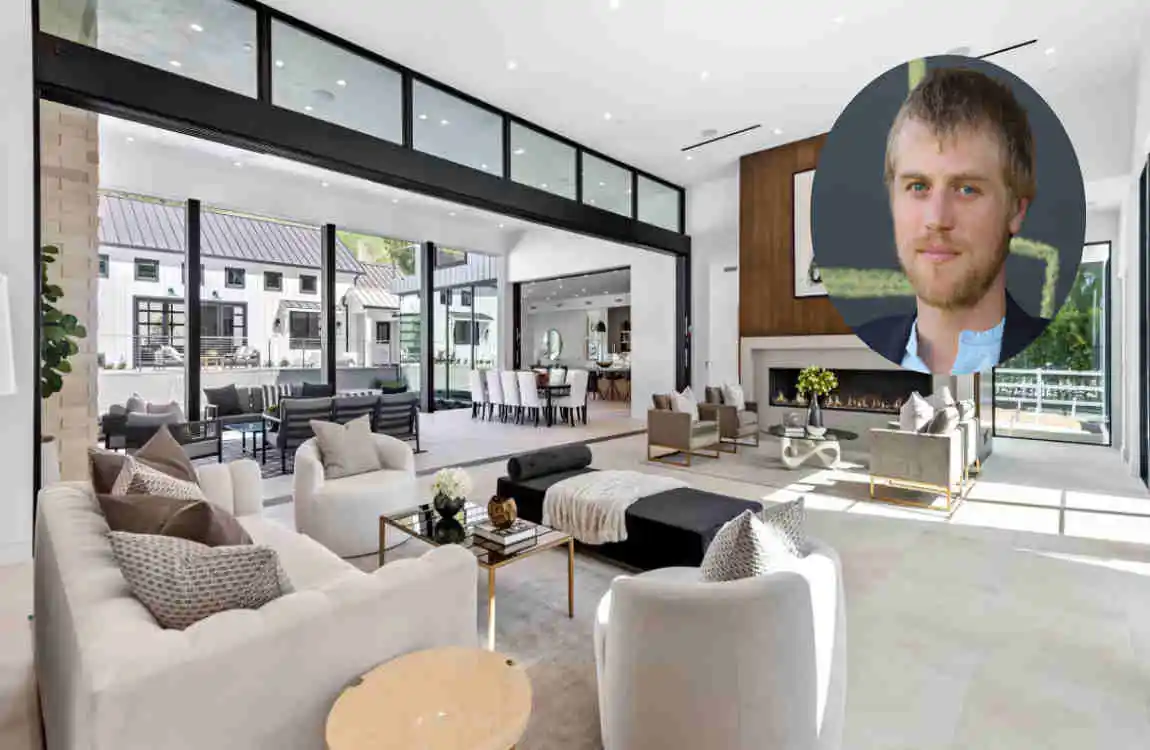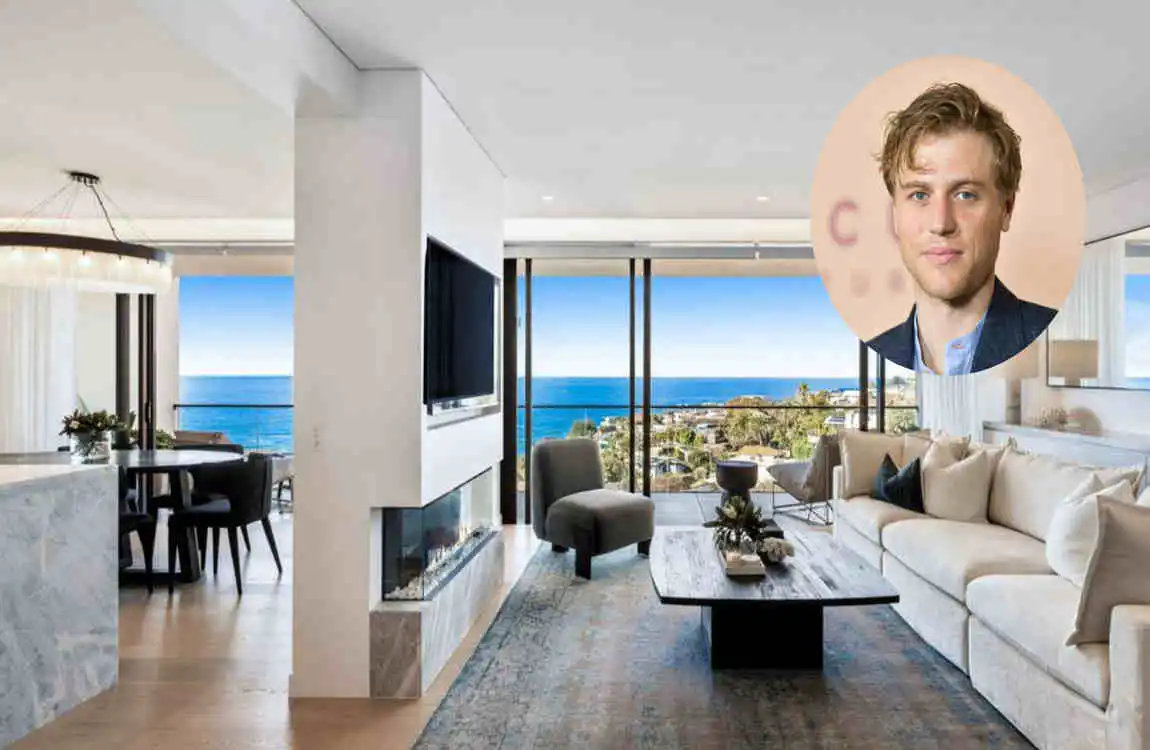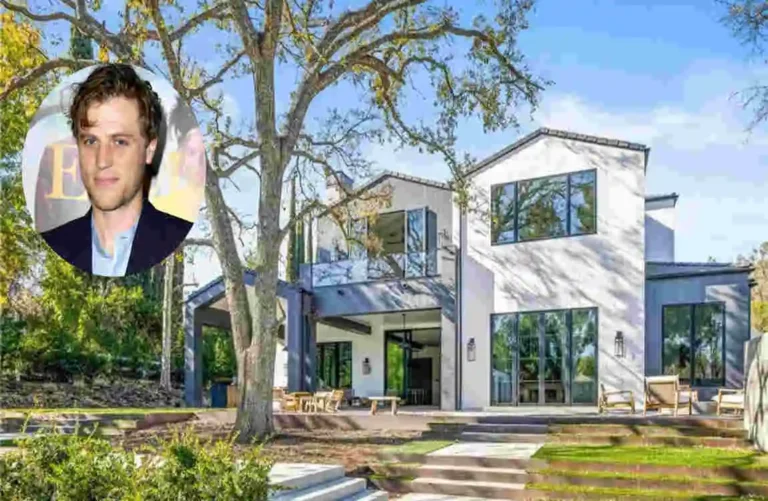Have you ever walked past a home that made you stop in your tracks? Johnny Flynn’s house does precisely that. Nestled in the heart of contemporary design discourse, this remarkable residence transcends mere shelter, becoming a living, breathing work of art.
The British actor, musician, and poet Johnny Flynn has long captivated audiences with his creative versatility. Yet beyond his artistic endeavors, Flynn has emerged as an unexpected tastemaker in residential design. His home stands as a bold architectural statement that challenges conventional notions of modern living.
The Johnny Flynn house represents more than personal taste. It embodies a philosophy of living that prioritizes authenticity over ostentation. The residence achieves icon status through its distinctive material palette, revolutionary spatial arrangements, and profound connection to its natural surroundings. Each design decision reflects a deeper narrative about modern life, creativity, and the human need for meaningful spaces.
Architectural Form and Materials

Exterior Language
The silhouette of Johnny Flynn’s house immediately sets it apart from neighboring properties. Rather than competing for attention through size or ornamentation, the structure commands presence through restraint and proportion. The roofline creates a dynamic profile that shifts depending on your viewing angle. Sharp geometric forms soften where they meet organic landscaping elements.
The material palette speaks volumes about the home’s design philosophy. Weathered timber cladding wraps portions of the exterior, developing a silver-gray patina that deepens with each passing season. This natural aging process isn’t hidden but celebrated. The wood tells the story of time through its changing surface texture.
Brick elements ground the structure with traditional British architectural heritage. Yet these aren’t your standard red bricks. Handmade variations in color and texture create subtle visual rhythms across the facade. Some bricks appear almost charcoal, others warm terracotta. This intentional irregularity brings life to what could otherwise feel static.
Metal accents provide contemporary counterpoints. Corten steel panels frame key architectural moments, their rusty orange hue creating a dramatic contrast against cooler materials. Window frames in dark bronze echo industrial aesthetics while maintaining residential warmth. These metal elements age gracefully, developing unique patinas that make the house feel increasingly rooted in place.
Structural Honesty
The house doesn’t hide its bones. Exposed steel beams celebrate structural logic rather than concealing it behind drywall. You can trace load paths from the roof to the foundation, intuitively understanding how the building stands. This transparency creates educational moments for visitors while adding industrial elegance to living spaces.
Column spacing follows a rhythmic pattern that organizes both interior and exterior zones. The structural grid becomes a design feature rather than a constraint. Posts and beams frame views like picture frames, directing attention toward carefully curated vistas.
Interior-Exterior Continuity
The most striking feature is the dissolution of boundaries between inside and outside. Floor-to-ceiling glass panels slide away completely, transforming enclosed rooms into open-air pavilions. During the summer months, the living room effectively doubles in size as it spills onto the terraces.
Courtyards puncture the building envelope, bringing nature deep into the home’s heart. These aren’t afterthoughts but integral design elements. A central courtyard serves as the home’s lungs, drawing in fresh air from adjacent spaces. Mature trees grow through carefully positioned openings, their branches becoming living sculptures visible from multiple rooms.
Material continuity reinforces this inside-outside dialogue. The same stone flooring flows from interior spaces through glass walls onto exterior patios. Without visual interruption, your eye travels freely between realms. This design strategy makes modest square footage feel expansive and generous.
Spatial Organization and Everyday Living
Plan Logic
The Johnny Flynn house revolutionizes traditional residential planning through intelligent zoning. The public and private realms coexist in harmony without rigid separation. The ground floor dedicates itself to communal life. Kitchen, dining, and living areas flow together in an open arrangement that encourages interaction.
Yet privacy hasn’t been sacrificed for openness. Acoustic barriers subtly separate zones without visual obstruction. A change in ceiling height signals a transition from public to semi-private space. Floor materials shift from hard surfaces in social areas to softer textures in quiet zones.
The upper level creates a private sanctuary. Bedrooms cluster around a central hallway that doubles as a library. Built-in bookshelves line the walls, transforming circulation space into functional storage and display. This clever use of transitional areas maximizes every square foot.
Room Relationships
Multi-functionality defines each space within the modern house. The dining room transforms into a workspace during daylight hours. Concealed storage systems hide work materials when entertaining begins. A long oak table serves equally well for family meals, creative projects, or impromptu meetings.
The kitchen extends beyond cooking into social theater. A massive island becomes the home’s gravitational center, drawing family and guests into culinary participation. Open shelving displays ceramics and glassware as functional art. Every tool and ingredient finds its designated place within arm’s reach.
Flexible furniture systems allow spaces to adapt to changing needs. Modular seating in the living room reconfigures for intimate conversations or larger gatherings. Built-in benches provide overflow seating while concealing storage beneath upholstered cushions.
Light and Atmosphere
Natural light orchestrates daily rhythms throughout the house. East-facing windows flood breakfast areas with morning sunshine. As the day progresses, light migrates through spaces, creating ever-changing atmospheres. By evening, western exposures capture golden sunset hues.
Window sizing follows a careful strategy. Clerestory windows bring light deep into rooms without sacrificing privacy. Lower windows frame specific views while controlling solar gain. Operable skylights create chimney effects, drawing cool air through the house during summer months.
The play between light and shadow adds dramatic depth. Deep roof overhangs protect interiors from harsh midday sun while allowing lower-angle winter light to penetrate deeply. This passive solar design reduces energy consumption while creating comfortable living conditions year-round.
Materiality, Color, and Craft
Texture and Tactility
Every surface in the Johnny Flynn house invites touch. Raw concrete walls reveal the texture of their wooden formwork, creating subtle patterns that catch raking light. Running your hand along these surfaces, you feel the authentic roughness that speaks to honest construction methods.
Wood appears in multiple expressions throughout the home. Wide-plank oak floors show natural grain patterns and occasional knots. These imperfections aren’t hidden but celebrated as evidence of the material’s organic origins. Walnut millwork provides rich contrast, its chocolate tones warming cooler concrete and steel elements.
Soft materials balance more complex surfaces. Linen curtains filter light while adding movement to static architectural elements. Wool rugs define seating areas while providing acoustic absorption. Leather upholstery ages gracefully, developing unique patinas that tell stories of daily use.
Color Strategy
The color palette draws from nature’s subtle spectrum. Warm grays dominate wall surfaces, shifting from cool concrete to warmer plaster tones. These neutral backgrounds allow furniture and art to provide color accents without overwhelming the space.
Earth tones ground the composition. Ochre, sienna, and umber appear in textile selections and decorative objects. These colors connect to the British landscape, echoing autumn leaves and weathered stone. Nothing feels artificially bright or out of place.
Strategic color moments create focal points. A deep blue accent wall in the study provides a backdrop for book spines and artwork. Sage-green tiles in the bathroom reference garden foliage visible through the windows. These color choices feel intentional yet effortless.
Craft and Detailing
Visible craftsmanship elevates everyday elements to art. Hand-forged iron hardware shows hammer marks that catch light differently from every angle. Door handles feel substantial in your grip, their weight communicating quality and permanence.
Joinery details reveal meticulous attention. Dovetail joints in drawer construction showcase traditional woodworking skills. Built-in furniture fits so precisely that gaps between components nearly disappear. These details might escape casual observation but reward closer inspection.
Bespoke finishes make each room unique. Hand-troweled plaster creates subtle texture variations that mass-produced drywall could never achieve. Custom tile patterns in bathrooms form geometric compositions that feel both modern and timeless.
Lighting, Acoustics, and Sensory Experience

Daylight Mastery
The Johnny Flynn house treats daylight as a building material. North-facing skylights provide consistent, diffused illumination for artwork and reading areas. These openings eliminate harsh shadows while maintaining even light levels throughout the day.
Window placement follows both functional and poetic logic. Corner windows dissolve structural corners, making rooms feel larger and more connected to the outdoors. Narrow vertical windows create light slots that track the sun’s movement, marking time through shifting light patterns on interior walls.
Shading devices prevent glare without blocking views. Adjustable louvers allow precise light control while maintaining ventilation. External blinds protect south-facing glass during the summer months. These systems operate manually, encouraging inhabitants to engage actively with their environment.
Night Ambience
After sunset, artificial lighting creates intimate atmospheres. Warm LED strips hidden in ceiling coves provide ambient illumination without visible fixtures. This indirect lighting eliminates harsh shadows while creating a sense of architectural levitation.
Task lighting appears exactly where needed. Adjustable reading lights flank the bed, providing focused illumination without disturbing partners. Under-cabinet lighting in the kitchen illuminates work surfaces without creating glare on glossy countertops.
Accent lighting highlights architectural features. Uplights graze textured walls, emphasizing material qualities invisible during daylight hours. Artwork receives dedicated illumination from museum-quality fixtures that protect against UV damage while revealing true colors.
Acoustic Comfort
Sound management creates peaceful living environments. Acoustic panels disguised as artwork absorb excess reverberation in open-plan areas. These treatments prevent the echo chamber effect common in minimalist interiors.
Material choices contribute to acoustic comfort. Cork flooring in the music room provides sound isolation while feeling warm underfoot. Heavy curtains serve double duty, controlling both light and sound transmission between spaces.
Strategic placement of soft furnishings manages noise levels. Upholstered furniture and area rugs absorb sound energy that would otherwise bounce off hard surfaces. The result feels calm without being unnaturally quiet.
Influence, Narratives, and Cultural Impact
Design Dialogue
The Johnny Flynn house has sparked conversations across architectural media. Design blogs dissect their material choices. Architecture students study its spatial arrangements. The residence regularly appears in international design publications, each article offering new perspectives on its significance.
Professional architects reference the house when discussing contemporary British residential design. Its influence extends beyond aesthetic choices to fundamental questions about how we live. The project challenges assumptions about celebrity homes, proving that fame doesn’t require ostentation.
Social media has amplified the house’s reach. Instagram posts featuring interior vignettes generate thousands of likes and saves. Pinterest boards dedicated to “Johnny Flynn house style” proliferate, spreading design ideas to global audiences.
Icon Status Through Storytelling
The house has become a character in Flynn’s creative narrative. Music videos filmed in the space showcase its atmospheric qualities. Interview backdrops reveal glimpses of daily life within these carefully crafted interiors. The residence provides an authentic context for understanding Flynn’s artistic process.
Documentary footage captures the house’s role in creative work. Recording sessions in the music room demonstrate how architecture supports artistic practice. The space becomes a collaborator rather than a mere container, shaping musical outcomes through its acoustics and ambiance.
Media coverage extends beyond design press. Lifestyle magazines feature the house as an exemplar of sustainable Luxury. Environmental publications highlight its passive solar strategies and material choices. This cross-disciplinary attention reinforces its icon status.
Influence on Trends
Elements from the Johnny Flynn house are now found in homes worldwide. The combination of raw concrete and warm wood has become a signature look. Open-plan layouts that maintain acoustic privacy inspire countless renovations.
Yet imitation often misses essential qualities. Superficial copying of material palettes fails to capture the house’s more profound logic. The original succeeds through holistic thinking rather than isolated design moves. Context, climate, and lifestyle considerations shape every decision.
Some interpretations improve upon original ideas. Designers adapt concepts for different climates and cultures. The house’s influence becomes a starting point for innovation rather than an endpoint for copying.
Practical Takeaways for Readers
What Readers Can Borrow
You don’t need celebrity budgets to incorporate lessons from the Johnny Flynn house. Start with natural light strategies. Rearrange furniture to maximize daylight exposure. Remove heavy window treatments that block precious sunshine. Paint walls in light colors that reflect rather than absorb illumination.
Material honesty translates to any budget. Expose existing brick walls rather than covering them with drywall. Sand and seal concrete floors instead of hiding them under carpet. Celebrate the authentic character of your home’s construction rather than disguising it.
Create flexible spaces within existing rooms. Moveable furniture allows adaptation to changing needs. A dining table on casters can shift between positions. Modular shelving systems reconfigure as collections grow or shrink.
Sustainability angles make upgrades responsible. Reclaimed materials provide character while reducing environmental impact. Local craftspeople create custom elements that support community economies. Energy-efficient systems minimize long-term operating costs.
Common Design Pitfalls
Avoid over-polishing spaces into sterility. The Johnny Flynn house succeeds through controlled imperfection. Embrace natural wear patterns. Allow materials to age gracefully. Perfect surfaces feel institutional rather than luxury residential.
Resist trend-chasing that ignores context. What works in the British countryside might fail in urban apartments. Consider your specific climate, lifestyle, and maintenance capacity. Design decisions should emerge from real needs rather than magazine spreads.
Quick Reference Checklist:
- Maximize natural light through strategic furniture placement
- Expose and celebrate authentic materials
- Create flexible, multi-functional spaces
- Invest in quality where you’ll notice it daily
- Allow materials to age and patina naturally
- Consider acoustic comfort alongside visual design
- Connect interior spaces to outdoor areas
Visuals and Case Studies
Imagery Roadmap
Photographing spaces like the Johnny Flynn house requires strategic planning. Facade shots work best during golden hour when low-angle light emphasizes texture. Wide-angle lenses capture the relationship between building and landscape. Detail shots of material intersections reveal construction quality.
Interior vignettes tell stories about daily life. Styled compositions should feel natural rather than staged. Include signs of habitation, such as open books, fresh flowers, or steaming coffee cups. These elements humanize architectural photography while maintaining design focus.
Material close-ups celebrate craft and texture. Macro photography reveals wood grain, concrete aggregate, and textile weaves. These images help readers understand tactile qualities that standard room photos miss. Natural light works better than flash for capturing authentic material character.
Daylight scenes demonstrate passive solar strategies. Time-lapse photography could track light movement through spaces. Before-and-after comparisons show how bedrooms transform between seasons. These dynamic representations convey experiential qualities that static images cannot capture.
Comparative Mini-Case Studies
The Farnsworth House by Mies van der Rohe shares the Johnny Flynn house’s transparency between inside and outside. Both structures use glass extensively, but for different purposes. Farnsworth pursues pure minimalism while Flynn’s house embraces material warmth. The comparison illuminates how similar strategies serve different philosophies.
Kettle’s Yard in Cambridge provides another useful parallel. This house-museum balances art display with domestic comfort. Like Flynn’s residence, it demonstrates how cultural objects integrate with daily life. Both spaces reject the sterile gallery aesthetic in favor of lived-in authenticity.
These comparisons contextualize the Johnny Flynn house within broader design traditions. Understanding precedents helps readers appreciate innovations while recognizing continuing conversations in residential architecture.
Data and Provenance
Reliable sources for further research include the Architects’ Journal and Dezeen for technical details. The RIBA Journal provides a critical analysis of the house’s environmental strategies. Local planning documents offer insights into material specifications and construction methods.
Floor plans remain largely private, respecting the owner’s privacy. However, analytical diagrams based on published photographs help understand spatial relationships. These interpretive drawings focus on design principles rather than exact dimensions.
Where Does Johnny Flynn Currently Live?
Johnny Flynn currently lives in London, England, with his wife and their three children. He has been reported over the years to reside on the edge of Hackney Marshes in east London, and other interviews and profiles have placed him in various London-area settings as his family life and acting/music career have evolved.

